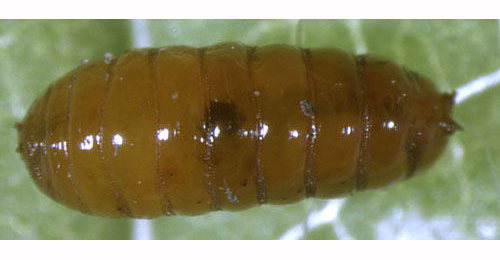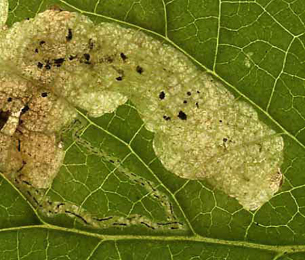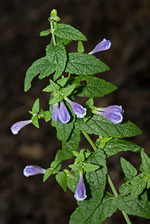|
||||||
|
SCUTELLARIA. Skullcaps. [Lamiaceae] |
|
|
Four species of Scutellaria are recorded in Britain. These include the native Skullcap (S. galericulata) and Lesser Skullcap (S. minor). The BSBI provide a downloadable plant crib for Scutellaria. Two British miners are recorded on Scutellaria. A key to the European miners recorded on Scutellaria is provided in Bladmineerders van Europa.
|
|
Key for the identification of the known mines of British |
1a >Leaf-miner: An initially linear mine, which at second instar develops into a large whitish blotch with conspicuous black frass. The early linear mine is frequently entirely enveloped by the blotch but is detectable by the alternate irregular strips of frass. Pupation external (Spencer, 1976: 158). The first part of the mine consists of a long, slender upper-surface corridor. After the first moult this changes into a large primary blotch without feeding lines. Frass in the corridor in short, somewhat angular thread fragments, towards the end even in grains. Frass arranged less closely along the sides than in A. lamii. Pupation outside the mine. The frass is conspicuous in the mine and the mine is initially linear, then develops into a white blotch, often enveloping this early mine. |
|
Amauromyza morionella (Zetterstedt, 1848) [Diptera: Agromyzidae]. |
1b > Leaf-miner: A linear-blotch mine, first instar mine is linear, later developing into a conspicuous white blotch. Frass greenish diffused (Spencer, 1972b: 46, 47 (fig. 138); Spencer, 1976: 166). The mine begins with a long, upper-surface, slender corridor. After a moult the larva changes its behaviour, and makes a large, upper-surface primary blotch without apparent feeding lines. Often the blotch overruns more or less the initial corridor. Frass in the corridor liquified to form a wide green band, with a few tiny black granules along the sides. Pupation outside the mine. A narrow gallery leading to a largish blotch on the upper surface. Frass is green and indistinct in the gallery - small grains may be seen at the gallery edge. |
 Amauromyza labiatarum puparium Image: © Willem Ellis (Bladmineerders van Europa) |
|
Amauromyza labiatarum (Hendel, 1920) [Diptera: Agromyzidae]. |
| 1c > Leaf-miner: Initially a long, slim corridor, the frass alternating on either the side of the corridor. After moulting, the larva broadens the mine and the frass is less regular. Pupation external. |
 Mine of Amauromyza lamii on Stachys sylvatica Image: © Willem Ellis (Bladmineerders van Europa) |
|
| Amauromyza lamii (Kaltenbach, 1858) [Diptera: Agromyzidae]. |
| Last updated 07-Jul-2019 Brian Pitkin | ||

